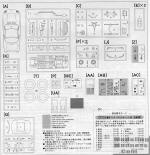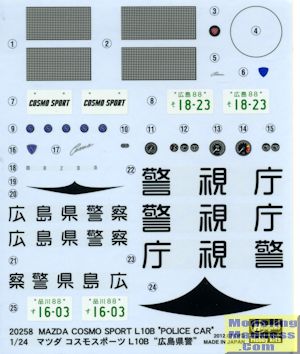
Hasegawa 1/24 Mazda Cosmo Sport L10B "Police Car"
| KIT #: | 20258 |
| PRICE: |
$2560 yen at
www.hlj.com
(about $21.00) (3200 yen SRP) |
| DECALS: | Two options |
| REVIEWER: | Scott Van Aken |
| NOTES: | 2012 boxing |

| HISTORY |
The Mazda Cosmo was a grand touring coupé produced by Mazda Motor Corporation from 1967 to 1995. Throughout its history, the Cosmo served as a "halo" vehicle for Mazda, with the first Cosmo successfully launching the Mazda Wankel engine. The final generation of Cosmo served as Mazda's flagship vehicle in Japan, being sold as the Eunos Cosmo through its luxury Eunos division in Japan.
Mazda chose to use the name cosmo, reflecting international cultural fascination with the Space Race, as Mazda wanted to showcase the rotary engine as forward-thinking, with a focus on future developments and technology.
The first Mazda to bear the Cosmo name (called the 110S on models intended for export) was the first 2-rotor rotary engine powered series car. A prototype was introduced at the 1964 Tokyo Motor Show after the introduction of the German made NSU Spider also in 1964 at the Frankfurt Motor Show, and 80 pre-production Cosmos were produced for the Mazda test department (20) and for dealership testing (60) between 1965 and 1966. Full production began in May 1967 and lasted through 1972, though Cosmos were built by hand at a rate of only about one per day, for a total of 1,519 (343 Series I cars and 1,176 Series II cars). The car was also featured in the show Return of Ultraman.
The Series I/L10A Cosmo was powered by a 0810 two-rotor engine with 982 cc of displacement and produced about 110 hp (thus the 110 name). It used a Hitachi 4-barrel carburetor and an odd ignition design - two spark plugs per chamber with dual distributors. A 4-speed manual transmission and 14 inch (335 mm) wheels were standard.
The front independent suspension was A-arm/coil spring design with an anti-roll bar. The rear used a live axle with a de Dion tube, trailing arms, and semi-elliptic leaf springs. Power-unassisted 10 inch (254 mm) disk brakes were found in front with 7.9 inches (201 mm) drum brakes in the rear. Performance in the quarter-mile (400 m) was 16.4 s, with a 115 mph (185 km/h) top speed. The price was lower than the Toyota 2000GT at 1.48 million yen (US$4,100).
The Series II/L10B was introduced in July, 1968. It had a more-powerful 128 hp (95 kW)/103 lb·ft (140 N·m) 0813 engine, power brakes, 15 inch wheels and a 5-speed manual transmission. The wheelbase had been expanded by 15 inches (38.1 cm) for more room and a better ride. This Cosmo was good for over 120 mph (193 km/h) and could accelerate to cover a quarter mile (400 m) in 15.8 s.
Visual changes included a larger grille under the front bumper with two additional vents to each side of this "mouth". Only 1,176 were ever made, and fewer than six Series II models were initially imported into the United States. The price was up a bit to 1.48 million yen (US$4,390).
Comedian and former talk show host Jay Leno owns a 1970 Series II Cosmo which was featured on the North American Speed Channel series My Classic Car in March, 2006. It was believed to be the only remaining Series II Cosmo in the United States, though the original Cosmo 10a engine was replaced with an RX-7 12a.
However, Mazda's U.S. division "found another in the garage of Phoenix-area car collector Glenn Roberts and made an offer that he couldn't refuse," according to Car and Driver magazine's September 2007 issue ("A Tale of Two Rotaries").
There is a Series II Cosmo in a collection in Alberta, Canada as well. A little over 1,500 of these early cars were made.
| THE KIT |
 Many
American modelers do not think of Hasegawa when it comes to car kits, yet their
automotive products are as good if not better than those produced by Japan's
other car kit makers. This one is no exception. The kit is molded in black and
white plastic for the most part. There are extensive chrome plated sprues and
also clear and clear red bits, especially for the police bits. Interestingly,
the tail light lenses are molded in clear so you'll need to paint those.
Many
American modelers do not think of Hasegawa when it comes to car kits, yet their
automotive products are as good if not better than those produced by Japan's
other car kit makers. This one is no exception. The kit is molded in black and
white plastic for the most part. There are extensive chrome plated sprues and
also clear and clear red bits, especially for the police bits. Interestingly,
the tail light lenses are molded in clear so you'll need to paint those.
There is a one-piece floor pan onto which the various suspension and exhaust pieces are attached. THe kit does not have a full engine, only the lower piece to which the exhaust are attached, so the kit is a curbside. Much of the empty engine compartment is covered up by the forward skid plate that fits over the front suspension piece. The front wheels are designed to be able to be turned so the steering arm simply clips onto the spindles.
Inside, there is a back seat of sorts that is more for small children and cargo than adults. A neat piece that is included are floor mats. You are provided with a square of material and a template to use when cutting them out. Decals are provided for the front seat inserts. Separate wheels and hub caps are provide onto which one fits the rubber tires.
For the body there are a number of small chrome bits that are on a
sticky backing. One gently peels these off and applies them where needed. This
is to be done after the body has been painted, of course. Another
 piece
that will need to fabricated is the front radiator screen. Again, screen
material is provided as is a template for producing ghis feature. While the kit
is designed to be outfitted as a law enforcement vehicle and Hasegawa has
including all the proper bits, one could easily make this as a standard civilian
vehicle by leaving off the lights and sirens.
piece
that will need to fabricated is the front radiator screen. Again, screen
material is provided as is a template for producing ghis feature. While the kit
is designed to be outfitted as a law enforcement vehicle and Hasegawa has
including all the proper bits, one could easily make this as a standard civilian
vehicle by leaving off the lights and sirens.
Instructions are excellent and provide all the required painting information as well as templates for the various bit. There are markings for two vehicles. One is a car for the Ministry of Transportation and Highway Traffic police, Hiroshima Prefectural Police. The other is for the Metropolitan Police Department riot police traffic direction. Yeah, I'm not really sure what all the means either. In any case, the decal sheet, which not only provides instrument panel decals, has all the various police logos as well as the forward hood wedge, which is a different size on the two cars. You can paint this one any color as long as it is black and white.
| CONCLUSIONS |
Kits like this are a great change of pace from the usual mass of GM, Ford, and Chrysler products. I would bet that few of your car modeling friends has something like this and it is thanks to Hasegawa for producing what looks like a great kit.
| REFERENCES |
http://en.wikipedia.org/wiki/Mazda_Cosmo
April 2015
Thanks to www.hlj.com for the preview kit. You can find this kit at this link. your favorite hobby shop or on-line retailer.
If you would like your product reviewed fairly and fairly quickly, please contact the editor or see other details in the Note to Contributors.